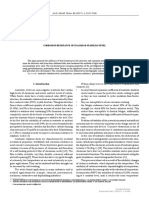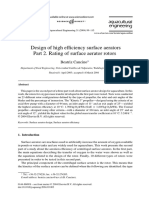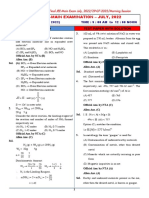0 ratings0% found this document useful (0 votes)
21 viewsMagnets
Magnets
Uploaded by
Saba QamarFerromagnetism arises due to quantum mechanical exchange forces between electron spins. The original mechanism of exchange interaction, proposed by Heisenberg in 1928, describes how electrostatic forces between electrons on the same atom couple their spin states. This coupling energy between electron spins is equivalent to an interaction that can give rise to ferromagnetism. The alignment of these tiny electron dipoles within atoms produces large internal magnetic fields characteristic of ferromagnetic materials.
Copyright:
© All Rights Reserved
Available Formats
Download as PDF, TXT or read online from Scribd
Magnets
Magnets
Uploaded by
Saba Qamar0 ratings0% found this document useful (0 votes)
21 views3 pagesFerromagnetism arises due to quantum mechanical exchange forces between electron spins. The original mechanism of exchange interaction, proposed by Heisenberg in 1928, describes how electrostatic forces between electrons on the same atom couple their spin states. This coupling energy between electron spins is equivalent to an interaction that can give rise to ferromagnetism. The alignment of these tiny electron dipoles within atoms produces large internal magnetic fields characteristic of ferromagnetic materials.
Original Description:
Magnets
Copyright
© © All Rights Reserved
Available Formats
PDF, TXT or read online from Scribd
Share this document
Did you find this document useful?
Is this content inappropriate?
Ferromagnetism arises due to quantum mechanical exchange forces between electron spins. The original mechanism of exchange interaction, proposed by Heisenberg in 1928, describes how electrostatic forces between electrons on the same atom couple their spin states. This coupling energy between electron spins is equivalent to an interaction that can give rise to ferromagnetism. The alignment of these tiny electron dipoles within atoms produces large internal magnetic fields characteristic of ferromagnetic materials.
Copyright:
© All Rights Reserved
Available Formats
Download as PDF, TXT or read online from Scribd
Download as pdf or txt
0 ratings0% found this document useful (0 votes)
21 views3 pagesMagnets
Magnets
Uploaded by
Saba QamarFerromagnetism arises due to quantum mechanical exchange forces between electron spins. The original mechanism of exchange interaction, proposed by Heisenberg in 1928, describes how electrostatic forces between electrons on the same atom couple their spin states. This coupling energy between electron spins is equivalent to an interaction that can give rise to ferromagnetism. The alignment of these tiny electron dipoles within atoms produces large internal magnetic fields characteristic of ferromagnetic materials.
Copyright:
© All Rights Reserved
Available Formats
Download as PDF, TXT or read online from Scribd
Download as pdf or txt
You are on page 1of 3
Quantum Mechanical Exchange Forces,
involving the spins of the electrons, are
responsible for the phenomenon of
Ferromagnetism.
Ferromagnetism arises due to quantum
mechanical exchange forces.
The mechanism of exchange interaction, as
originally proposed by Heisenberg in 1928, is
one in which the forces involved are electrostatic
in origin, but which, because of the constraints
imposed by Pauli Exclusion Principle, are
formally equivalent to a very large coupling
between the electron spins.
Consider two electrons with two spin states
(up and down) each on different orbitals on the
same atom. Their spins can couple to form three
triplet and one singlet state. The triplet states
are symmetrical with respect to the interchange
of the two electrons whereas the singlet state is
anti-symmetrical.
Since only states whose overall symmetry is
anti-symmetrical are allowed in nature (due to
the Pauli Exclusion Principle), the spin triplet
states can only be combined with the orbital
symmetric state, and the singlet spin state with
the orbital symmetric state.
Although simple product of two electron
(orbital) states has the same energy if the
electrons are interchanged (one electron being
considered exactly the same as the other
electron), the symmetric or anti symmetric
combinations formed from these products no
longer have the same energy, because the
symmetrical solution allows the wave function to
have a large amplitude if the two electrons are at
the same point, while the anti-symmetrical wave
function then vanishes. Thus electrostatic
repulsive energy between the two electrons is
larger in the first case than in the second.
Because of the association of orbital and
spin states mentioned above, the energy
difference between orbital states of different
symmetry gets associated with an energy
difference between the spin-singlet and the spintriplet situations. This is tantamount to
introduction of a coupling energy between the
electron spins which is of the right form and
magnitude to give rise to Ferromagnetism.
The electron itself being a spinning charged
body acts like a spinning dipole (magnet). These
tiny internal spinning dipoles can interact and
get aligned to produce very large internal
magnetic fields which are usually found in
Ferromagnets.
The original Heisenberg model, with the
spins localized on the same atom, is a good
approximation in an ionic solid.
For Ni, Co or Fe, which are metals, an
improved model, in which the conduction
electrons serve as a medium through which an
interaction is transmitted between spins (which
are localized), is used.
(Ref: Electricity and Magnetism, Bleaney and
Bleaney, Oxford,1966, pp 650-1)
You might also like
- 05 0845 02 6RP AFP tcm142-623300Document8 pages05 0845 02 6RP AFP tcm142-623300Abdul Muneer DarNo ratings yet
- Aether and Structure of ElectronDocument7 pagesAether and Structure of ElectrondllabarreNo ratings yet
- Quantum Mechanical Treatment & Exchange Interactions: M.Phil. PhysicsDocument11 pagesQuantum Mechanical Treatment & Exchange Interactions: M.Phil. Physicsabdul mananNo ratings yet
- International Journal of Engineering Research and Development (IJERD)Document17 pagesInternational Journal of Engineering Research and Development (IJERD)IJERDNo ratings yet
- Electromagnetism: M C MC MCDocument3 pagesElectromagnetism: M C MC MCsushil4056No ratings yet
- Pauli Exclusion PrincipleDocument5 pagesPauli Exclusion Principlea4477728No ratings yet
- The Pauli Exclusion Principle Is One of The Most ImportantDocument4 pagesThe Pauli Exclusion Principle Is One of The Most Importantrajpal7590No ratings yet
- Spin Quantum NumberDocument13 pagesSpin Quantum NumberStela_Tololiu_5920No ratings yet
- A Short Note On The Nature of LightDocument3 pagesA Short Note On The Nature of LightFrederick David TombeNo ratings yet
- Stark Effect in Atomic SpectraDocument6 pagesStark Effect in Atomic Spectraflamesup41No ratings yet
- Electron Correlations in Narrow Energy BandsDocument20 pagesElectron Correlations in Narrow Energy BandsJoy RoyNo ratings yet
- Basic EPR Spectroscopy - TheoryDocument17 pagesBasic EPR Spectroscopy - TheoryDev DNo ratings yet
- What is Charge? – The Redefinition of Atom - Energy to Matter ConversionFrom EverandWhat is Charge? – The Redefinition of Atom - Energy to Matter ConversionNo ratings yet
- # Week 4 NotesDocument17 pages# Week 4 Notestimx123yNo ratings yet
- The Genesis ProjectDocument19 pagesThe Genesis Projectlaurentiu75No ratings yet
- Basic Principles of Electricity: Key Takeaways: Electricity and MagnetismDocument2 pagesBasic Principles of Electricity: Key Takeaways: Electricity and MagnetismNRIZA MAE CACHONo ratings yet
- Aether and The Electric Sea General ScienceDocument7 pagesAether and The Electric Sea General Sciencetedmer1No ratings yet
- IdeasDocument2 pagesIdeashanlkd96No ratings yet
- Unit 1 Electricity and MagnetismDocument81 pagesUnit 1 Electricity and Magnetismeric appiahNo ratings yet
- Maxwell's Sea of Molecular VorticesDocument7 pagesMaxwell's Sea of Molecular Vorticescrystal01heartNo ratings yet
- 29 - 130 Magnetic MaterialsDocument4 pages29 - 130 Magnetic MaterialspannNo ratings yet
- Gamma Ray Spectroscopy VerDocument12 pagesGamma Ray Spectroscopy VerLiberata MigloriaNo ratings yet
- Particle Physics Particle Physics Timeline Quark ConfinementDocument10 pagesParticle Physics Particle Physics Timeline Quark ConfinementPiyush AgrawalNo ratings yet
- The Aether and The Electric Sea (The Link Between Gravity and Electromagnetism)Document5 pagesThe Aether and The Electric Sea (The Link Between Gravity and Electromagnetism)Frederick David TombeNo ratings yet
- Zeeman and Paschen-Back EffectDocument12 pagesZeeman and Paschen-Back EffectKamanpreet Singh100% (1)
- The Bridge Between Classical and Quantum MechanicsDocument9 pagesThe Bridge Between Classical and Quantum MechanicsGeorge RajnaNo ratings yet
- 101 - Electron TheoryDocument2 pages101 - Electron TheorySeagullian DaveNo ratings yet
- Ama Computer College: Assignment Electricity and MagnetismDocument4 pagesAma Computer College: Assignment Electricity and MagnetismMary Jane Evardone EspinoNo ratings yet
- Electricity and MagnetismDocument7 pagesElectricity and MagnetismAlan GamingNo ratings yet
- Phys 3Document5 pagesPhys 3Wyndle PachecaNo ratings yet
- Exchange Force Model of Nuclear PhysicsDocument4 pagesExchange Force Model of Nuclear PhysicsJaydeep SinghNo ratings yet
- Pauli Exclusion PrincipleDocument3 pagesPauli Exclusion PrincipleMahabub HossainNo ratings yet
- # Week 3 NotesDocument13 pages# Week 3 Notestimx123yNo ratings yet
- Materials Engineering Course: Atomic Structure and Interatomic BondingDocument24 pagesMaterials Engineering Course: Atomic Structure and Interatomic BondingMuhammad NashirNo ratings yet
- Introduction To Heisenberg Model: Javier JunqueraDocument45 pagesIntroduction To Heisenberg Model: Javier JunqueraAshok GargNo ratings yet
- Induction of Electrostatic Repulsion by Strong GravityDocument10 pagesInduction of Electrostatic Repulsion by Strong GravityFrederick David TombeNo ratings yet
- Chemical Bonding/s2 Kimia UnpDocument36 pagesChemical Bonding/s2 Kimia UnpIda HidayatiNo ratings yet
- Magnetism Arises From Two Types of Motions of Electrons in AtomsDocument4 pagesMagnetism Arises From Two Types of Motions of Electrons in AtomsSajesh VallikkadanNo ratings yet
- Fundamental ForcesDocument6 pagesFundamental Forcesabhi130713071307No ratings yet
- Electromagnetic Wave and Journey of MaxwellDocument31 pagesElectromagnetic Wave and Journey of Maxwellram krishna NamdevNo ratings yet
- Elementary ParticlesDocument15 pagesElementary ParticlesBrighton Pako MaseleNo ratings yet
- EsrDocument13 pagesEsrChiranjeevi TulluriNo ratings yet
- Struktur Atom Dan Ikatan - Kimor 1Document30 pagesStruktur Atom Dan Ikatan - Kimor 1akbar_rozaaqNo ratings yet
- Structure of MatterDocument5 pagesStructure of MatterkewayikaNo ratings yet
- Electron Paramagnetic Resonance: Theory and Analysis: A B B B BDocument13 pagesElectron Paramagnetic Resonance: Theory and Analysis: A B B B BVikash AggarwalNo ratings yet
- Applied ChemistryDocument11 pagesApplied ChemistryMaqsood Ahmad KhanNo ratings yet
- Periodic Trends and The Octet RuleDocument5 pagesPeriodic Trends and The Octet Rule10chirag10No ratings yet
- Does Atom Have Electromagnetic FieldDocument5 pagesDoes Atom Have Electromagnetic FieldlivingHipHop 40No ratings yet
- Questions M2 Introduction To Nanomagnetism Introduction To Nano-Optics Year 2020. Joaquín Fernández RossierDocument7 pagesQuestions M2 Introduction To Nanomagnetism Introduction To Nano-Optics Year 2020. Joaquín Fernández Rossierdavido herreNo ratings yet
- ElectronDocument1 pageElectronMohamed BenkhettabNo ratings yet
- Electron Spin Resonance ExperimentDocument16 pagesElectron Spin Resonance ExperimentAtiq Ur RahmanNo ratings yet
- Atomic Structure and Inter Atomic Bond Lecture Note 2Document12 pagesAtomic Structure and Inter Atomic Bond Lecture Note 2Bolaji TunmiseNo ratings yet
- Module 6: Physics of Semiconductor Devices Lecture 30: Energy Band DiagramDocument10 pagesModule 6: Physics of Semiconductor Devices Lecture 30: Energy Band Diagramvj.krlambaNo ratings yet
- Chemical Bonding 7Document8 pagesChemical Bonding 7kritikasinha511No ratings yet
- Introduction Electricity and MagnetismaDocument3 pagesIntroduction Electricity and Magnetismadaileth paola brittto parejaNo ratings yet
- Triplet Lifetime LABDocument25 pagesTriplet Lifetime LABMatthew TaylorNo ratings yet
- Solid StateDocument42 pagesSolid StateM.AhmedNo ratings yet
- What Is The Difference Between Induced and Motional EmfDocument1 pageWhat Is The Difference Between Induced and Motional Emfanand_duraiswamyNo ratings yet
- 1 The Field ForcesDocument9 pages1 The Field ForcesMad_Max_HJNo ratings yet
- The Relations of Physics of Electrons to Other Branches of ScienceFrom EverandThe Relations of Physics of Electrons to Other Branches of ScienceNo ratings yet
- Eli-Chem Industrial Products BrochureDocument44 pagesEli-Chem Industrial Products BrochureCarlos BolvaranNo ratings yet
- Ejercicios Resueltos TransistoresDocument25 pagesEjercicios Resueltos TransistoresCeleste CorominasNo ratings yet
- Corrosion Resistance of X5CrNi18-10 Stainless SteeDocument6 pagesCorrosion Resistance of X5CrNi18-10 Stainless SteeKis GáborNo ratings yet
- 20 E - 0300.nsz Measurement ResultsDocument1 page20 E - 0300.nsz Measurement Resultsrefilda suhaili100% (1)
- Creep - EMM212 - Physical Metallurgy IIDocument34 pagesCreep - EMM212 - Physical Metallurgy IICalebNo ratings yet
- Comparison and Evaluation of Open-Source Panel Method Codes Against Commercial CodesDocument18 pagesComparison and Evaluation of Open-Source Panel Method Codes Against Commercial CodesElif OguzNo ratings yet
- Chapter 2 Lesson 1 2 1Document7 pagesChapter 2 Lesson 1 2 1Rudolf Dwight MaqueraNo ratings yet
- Kimia Jawaban Tugas Kimia IntiDocument24 pagesKimia Jawaban Tugas Kimia IntiMonica Puspita SariNo ratings yet
- Petroleum Engineering GATE 2020 SolutionsDocument33 pagesPetroleum Engineering GATE 2020 SolutionsGate Aiots Petroleum AdminNo ratings yet
- Design of High Efficiency Surface Aerators Part 2. Rating of Surface Aerator RotorsDocument17 pagesDesign of High Efficiency Surface Aerators Part 2. Rating of Surface Aerator RotorsArun JothyNo ratings yet
- Acelerometro Acc310Document1 pageAcelerometro Acc310Byron JimenezNo ratings yet
- Seal-Lock Apex: All Pressure EnvironmentsDocument8 pagesSeal-Lock Apex: All Pressure EnvironmentsHunter100% (1)
- Atoms & Molecules-1Document32 pagesAtoms & Molecules-1Raghav GoelNo ratings yet
- Test Series For Neet-2020Document16 pagesTest Series For Neet-2020kavyareddyNo ratings yet
- Agitation and Mixing AerationDocument46 pagesAgitation and Mixing AerationM M BillahNo ratings yet
- Steel: StructuresDocument29 pagesSteel: StructuresBa Thanh DinhNo ratings yet
- Axial Strength of Slotted Perforated Cold-Formed Steel Channels Under Pinned-Pinned Boundary ConditionsDocument15 pagesAxial Strength of Slotted Perforated Cold-Formed Steel Channels Under Pinned-Pinned Boundary ConditionsDinesh LakshmananNo ratings yet
- Brochure Adv NDT - PT. Prominent Energy ServicesDocument2 pagesBrochure Adv NDT - PT. Prominent Energy ServicesRizki YudaNo ratings yet
- p340-h340 OptronDocument19 pagesp340-h340 Optronfyusupov882No ratings yet
- 2907 Chemistry Paper With Solution MorningDocument8 pages2907 Chemistry Paper With Solution MorninghelioNo ratings yet
- CSWIP 3.0 Visual Inspection RevisedDocument136 pagesCSWIP 3.0 Visual Inspection RevisedNguyen HuongNo ratings yet
- HaftaDocument5 pagesHaftaffra542No ratings yet
- CarraroDocument9 pagesCarraroronald enrique gareca ruedaNo ratings yet
- AMCA 250 WhitepaperDocument8 pagesAMCA 250 Whitepaperbergun260No ratings yet
- Research ArticleDocument8 pagesResearch ArticleUsama Bin RaisNo ratings yet
- PLS CADD PretensadoDocument10 pagesPLS CADD PretensadoJoaquin A. Vásquez TantaleánNo ratings yet
- Electrical Wiring HistoryDocument17 pagesElectrical Wiring Historymotowerx100% (5)
- Classical MechanicsDocument3 pagesClassical MechanicsMr. BaiGNo ratings yet
- University of Tripoli Faculty of Engineering Petroleum EngineeringDocument10 pagesUniversity of Tripoli Faculty of Engineering Petroleum EngineeringesraNo ratings yet

























































































